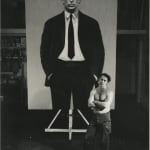Rudy Burckhardt
Pair of Photos Showing a Lost Portrait by Alfred Leslie, 1963-65
Silver prints (2)
Each 10 x 8 inches
With photographer's credit and manuscript notations verso.
With photographer's credit and manuscript notations verso.
Sold
Further images
Alfred Leslie is an American painter and filmmaker known for his large-scale portraits. This pair of photographs are rare documentations of two 9-foot self-portraits before they were destroyed in a...
Alfred Leslie is an American painter and filmmaker known for his large-scale portraits. This pair of photographs are rare documentations of two 9-foot self-portraits before they were destroyed in a fire. More than 50 grisaille paintings and drawings being prepared for a potential solo show at the Whitney Museum, as well as several unpublished texts and films that were yet to be mastered were lost in a fire that took his home and studio in 1966. The two paintings are almost identical in its contents: self-portraits spanning from the forehead and cutting off just above the knee—the suited figure’s intense expression meets the gaze of the viewer.
One photograph is a straightforward documentation of the work shot by Swiss American photographer, Rudolph Burckhardt, who was known for his prolific documentation of the New York School art scene. The other image gives a sense of the scale of these portraits as it shows a studio view of the artist standing in front of the painting, dwarfed by his giant painted likeness looming behind him. This second image is credited to "W.C. Fields," presumably a joke, but the meaning is on us.
Born October 29, 1927, in the Bronx, New York, Alfred Leslie fell into the art scene when he worked as a figure model and began filmmaking. His hobbies in bodybuilding and gymnastics led to an impressive physique that put him in demand for figure drawing classes at the Arts Student League and Pratt Institute. After serving in WWII in the Coast Guard, Leslie attended New York University under the GI Bill and brushed shoulders with the new generation of artists, writers, performers, and other creatives. It was not until the 1950s until he entered his Abstract Expressionist period and gained international attention for spearheading the second generation of AbEx painting. Continuing his film practice, he released “Pull My Daisy” in 1958 which starred notable figures from the Beat generation and other friends such as Jack Kerouac, Allen Ginsberg, Alice Neel, David Amram, and Leslie’s famed art dealer, Richard Bellamy. Later in the 1960s, Leslie moved into a new era of figurative compositions, which he is most known for today and established himself as a prominent member of the New York School. After the devastating fire in 1966 that wiped out his inventory, Leslie spent much of his time recreating what was lost as well as new work. He was the subject of a retrospective, a decade after the Whitney show was set to open, at the Museum of Fine Arts in Boston. He remains an influential artist from the downtown arts scene today where he currently resides and works.
One photograph is a straightforward documentation of the work shot by Swiss American photographer, Rudolph Burckhardt, who was known for his prolific documentation of the New York School art scene. The other image gives a sense of the scale of these portraits as it shows a studio view of the artist standing in front of the painting, dwarfed by his giant painted likeness looming behind him. This second image is credited to "W.C. Fields," presumably a joke, but the meaning is on us.
Born October 29, 1927, in the Bronx, New York, Alfred Leslie fell into the art scene when he worked as a figure model and began filmmaking. His hobbies in bodybuilding and gymnastics led to an impressive physique that put him in demand for figure drawing classes at the Arts Student League and Pratt Institute. After serving in WWII in the Coast Guard, Leslie attended New York University under the GI Bill and brushed shoulders with the new generation of artists, writers, performers, and other creatives. It was not until the 1950s until he entered his Abstract Expressionist period and gained international attention for spearheading the second generation of AbEx painting. Continuing his film practice, he released “Pull My Daisy” in 1958 which starred notable figures from the Beat generation and other friends such as Jack Kerouac, Allen Ginsberg, Alice Neel, David Amram, and Leslie’s famed art dealer, Richard Bellamy. Later in the 1960s, Leslie moved into a new era of figurative compositions, which he is most known for today and established himself as a prominent member of the New York School. After the devastating fire in 1966 that wiped out his inventory, Leslie spent much of his time recreating what was lost as well as new work. He was the subject of a retrospective, a decade after the Whitney show was set to open, at the Museum of Fine Arts in Boston. He remains an influential artist from the downtown arts scene today where he currently resides and works.







